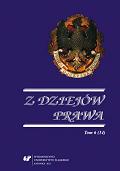Wydział Potrzeb Wojskowych i Komisariat Wojskowy za rządów Rady Zastępczej Tymczasowej — Cywilne organy władz wojskowych (19 kwietnia — 28 maja...)
A Department of Military Needs and Military Commissariat during the ruling of the Contemporary Replacement Council — Civil bodies of military...
Author(s): Jarosław DudzińskiSubject(s): Law, Constitution, Jurisprudence
Published by: Wydawnictwo Uniwersytetu Śląskiego
Summary/Abstract: A prototype of a Department of Military Needs of the Contemporary Replacement Council was a Department of Military Needs of an Ordering Commission of the Cracow voivodship. The scope of its competences was shaped in the course of doing certain tasks within army organization and supply in the insurrectionary Cracow. When the commission was appointed, Kościuszko commissioned it to first of all take care of the recruitment, create a local militia in Cracow and control the organization of the levy in mass. The authors of The Replacement Council undoubtedly knew the Cracow "Akt powstania…", rules of the organization of regulation commissions and there is much evidence that shows that it is just the Cracow models that served the purpose of the statute of Warsaw bodies, including a Department of Military Needs. When The Replacement Council was appointed, one of its distinguished departments was a Military Department. General major as well as commander in chief of armed forces Stanisław Mokronowski, was a head of it. Apart from Mokronowski, all members of the Department were civils, unfamiliar with administration and commissariat issues. Particular members of the Department were given groups of tasks connected with equipping and feeding the army, making them somehow the leaders of particular department of a Military Commissariat appointed later on. Basic tasks of a Military Department were the recruitment, providing accommodation, control over the training of new department, production and repair of arms, but also uniforms and providing the army with all necessary effects. The Military Commissariat, an executive body of the Military Department, was brought to life on 25 April. The commander nomination was given to general major Jan Augustyn Cichocki. The Commissariat was to compose 24 people altogether. Internally, the Commissariat was divided into the Central Management, and four departments: weapon and field hospitals, uniforms, food and forage, horses and carts of any kind, as well as central office. The staff of the Commissariat was completed basing on the army experience of its members or competences that could be useful taking into account the work of particular departments. The scope of duties of the Military Commissariat in terms of army supply, weaponry and equipment was huge and covered almost all areas of the army functioning. An organizational structure, established procedures, tightly outlined forms of action, a huge number of current issues made a Military Department, but also the Commissariat a ponderous body and little operative. A difficulty for the activity of the Department and the Commissariat was a weak material basis of the uprising. A constant political battle in the capital did not make it easier for the army municipalities to do the tasks efficiently. Despite existing difficulties, a Department of Military Needs of the Contemporary Replacement Council and the Military Commissariat performed their functions well to their...
Journal: Z Dziejów Prawa
- Issue Year: 14/2013
- Issue No: 6
- Page Range: 29-65
- Page Count: 37
- Language: Polish

